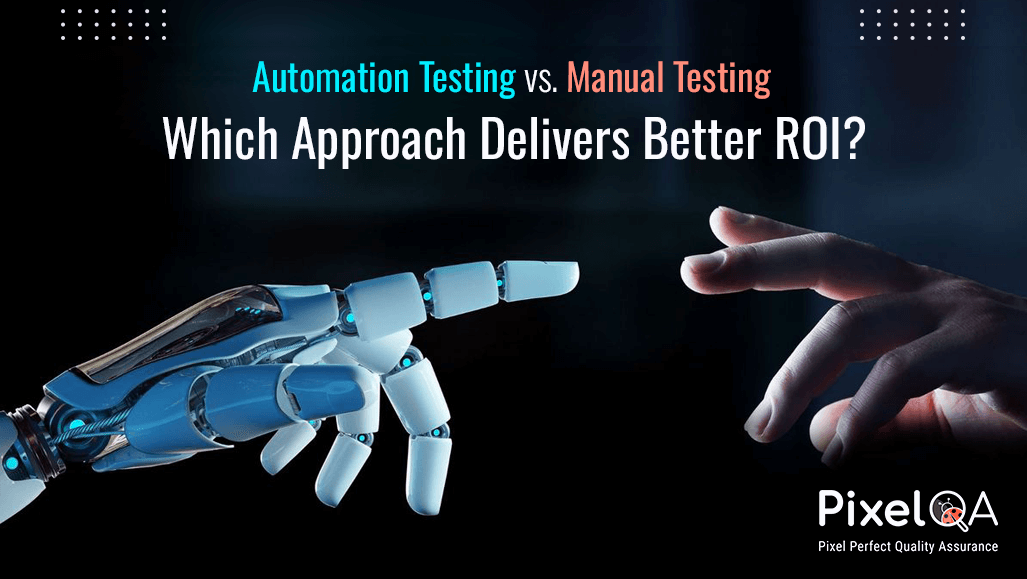
Table of Contents
- Introduction to ROI in Testing
- What is Automation Testing?
- Advantages of Automation Testing:
- Drawbacks of Automation Testing
- When Does Automation Testing Give Good ROI?
- What is Manual Testing?
- Advantages of Manual Testing
- When Does Manual Testing Give Good ROI?
- Comparing ROI: Automation vs. Manual Testing
- When to Use a Hybrid Approach?
- Why Hybrid Testing Works?
- Summary of Key Points
- Conclusion
Today, we will explore and understand the two main approaches to software testing, one is Automation Testing, and another one is Manual Testing. We will compare both methods for the Return on Investment they provide.
ROI means getting the best value and results for the money and efforts already been spent. For any company, choosing between automation and manual testing is about balancing quality and cost-effectiveness.
Introduction to ROI in Testing
Before we get involved in comparing the two types of testing, first understand the ROI in easy terms. In software testing, ROI is about getting maximum benefit (like saving money, reducing bugs, and improving quality) for the investment in testing. If a testing method requires a lot of time and money but doesn’t give much benefit, its ROI is low. The goal is to choose the testing approach that gives a high ROI for each project.
What is Automation Testing?
Automation testing service is nothing but using scripts and tools to run tests automatically. Instead of testers executing tests manually, testers write scripts that ask a machine to perform testing for them. The tools available in the market e.g. Selenium, Appium, and JMeter are quite popular in automation testing.
Advantages of Automation Testing:
- Speed and Efficiency: Compared to manual testing automation testing is fast. Once the scripts are set up, bundles can run in the loop without any delay. This makes it appropriate for bigger projects where time is a large factor.
- Consistency: Automation scripts don’t make mistakes because they follow instructions strictly. This makes automation testing highly consistent and reliable for repeated tests.
- Great for Repetitive Tests: Test suites that are required to be performed again and again are perfect tests to run using automation. E.g. if we need to test login functionality on different devices, automation testing is the way to go.
- Cost Savings Over Time: Although it can be costly initially, automation testing saves money in the long run, especially for large-scale projects.
- Better for Regression Testing: When new features are added, regression tests make sure older functions still work. Automation makes regression testing faster and more accurate.
Drawbacks of Automation Testing
- High Initial Cost: Setting up automation is expensive. You need trained testers who know scripting and might need to buy tools. Not every company can afford this upfront cost.
- Maintenance: As the software changes, automation scripts also need updates. This maintenance can add to costs and effort.
- Limited in Scope: Automation only tests what it's programmed for. It can’t think outside the box or test like a human user.
When Does Automation Testing Give Good ROI?
Automation testing is best for projects with repetitive tasks, frequent updates, or large-scale features that require testing across different scenarios. It provides a high ROI if there’s a need for regular, repeated tests over a long period. Automation also helps projects that need consistent results quickly.
What is Manual Testing?
Manual software testing is something called when a person manually tests the software, using actions that mimic a real user. This type of testing uses skills to identify the things that automation testing might miss, e.g. design or usability issues.
Advantages of Manual Testing
- Flexible and Adaptable: A tester can update the test process as it progresses, making it very flexible. They can find different ways to test based on their work experience and judgment.
- Low Initial Cost: Manual testing doesn’t need special tools or scripts, so it has a low starting cost. Any trained tester can begin testing right away.
- Good for Exploratory Testing: When exploring a new feature or trying to find unknown bugs, manual testing is more useful. It’s helpful when testers need to go beyond planned test cases.
- Better for UI/UX Testing: When testing the look and feel of an application, manual testing is ideal. Testers can check if buttons, links, and layouts work well and look correct.
Drawbacks of Manual Testing:
- Time-Consuming: Manual testing can be slow, especially for large projects. Every test must be done individually, which takes time.
- Human Error: Since humans get tired, there’s a higher chance of mistakes in repeated tests.
- Not Suitable for Repetitive Tasks: Manually testing the same thing repeatedly is not efficient. Automation is faster and more consistent for such tasks.
When Does Manual Testing Give Good ROI?
Manual testing is effective for small projects with few updates, one-time tests, or areas where human insight is needed. Manual testing is often better for testing user experience, visual design, and complex scenarios that require a human touch.
Comparing ROI: Automation vs. Manual Testing
- Time and Cost: Automation requires a high initial investment but saves time in the long run. Manual testing is cheaper at the start but becomes costly with time, especially for large projects. So, automation gives better ROI in large, ongoing projects, while manual testing is more economical for smaller projects.
- Quality and Coverage: Automation provides good quality and consistent results for repetitive tasks, giving better ROI. However, manual testing covers more creative and unique cases, especially for UI.
- Maintenance: Automation scripts need updates as software changes, which increases costs over time. Manual testing doesn’t need maintenance in this way, but it takes more effort if there are frequent changes. For projects with frequent updates, automation testing gives better ROI due to its repeatability.
- Adaptability and Flexibility: Manual testing is more adaptable, which is important in complex or unpredictable test cases. In such cases, manual testing can give better ROI as it saves costs on scripting and tool maintenance.
When to Use a Hybrid Approach?
Companies use goods of both automation and manual testing which brings the best results. This method known as hybrid testing, uses automation for repeated test runs and manual testing for areas that require a manual tester role.
Why Hybrid Testing Works?
- Automation for Repeated Tests: The automated test suites that handle repetitive work, e.g. regression tests, save time and improve ROI.
- Manual Testing for UI and UX: Manual testers focus on the software’s user experience, various scenarios, and areas that require the tester’s element.
In mixed testing, each type of testing includes each other’s weaknesses, it improves the ROI and makes sure that the testing process is efficient.
Summary of Key Points
Automation Testing Service gives good ROI in large projects, in-loop testing, and frequent releases.
Manual software testing is a cost-effective solution for smaller projects, one-time tests, and UI/UX testing.
A Hybrid method uses both automation and manual testing, which gives the best ROI by covering the in-loop execution and different testing needs.
In the end, there is no single solution for all the different projects. Every project is different and choosing the correct mixture of testing methods is based on the specific project requirements. We can maximize ROI and improve the product’s quality effectively.
Conclusion
Choosing the right testing approach depends on the project requirement, size, and especially budget. A software testing company can help determine the most effective testing strategy for your needs. The projects that require repetitive runs fast, and consistent test automation provide better ROI. But for the project that requires the tester’s insights, their manual testing gives better ROI.
About Author
 Hardik Mochi started his testing journey in October 2015 as a Junior Software Tester, and now he is an Associate Team Lead at PixelQA. With a focus on testing mobile apps, Windows applications, and web portals in the RX and CG domains, Hardik developed strong software testing skills. Progressing to Senior Tester over 5.5 years, he transitioned to XDuce India PVT LTD, specializing in ETL testing and acquiring SQL expertise, complemented by earning the AZ-900 certification. He is eager to delve into automation while maintaining interests in electronic hardware, current affairs, and geopolitics, aiming to advance as an automation professional in the future.
Hardik Mochi started his testing journey in October 2015 as a Junior Software Tester, and now he is an Associate Team Lead at PixelQA. With a focus on testing mobile apps, Windows applications, and web portals in the RX and CG domains, Hardik developed strong software testing skills. Progressing to Senior Tester over 5.5 years, he transitioned to XDuce India PVT LTD, specializing in ETL testing and acquiring SQL expertise, complemented by earning the AZ-900 certification. He is eager to delve into automation while maintaining interests in electronic hardware, current affairs, and geopolitics, aiming to advance as an automation professional in the future.

 (2)_638700949450158659.png)